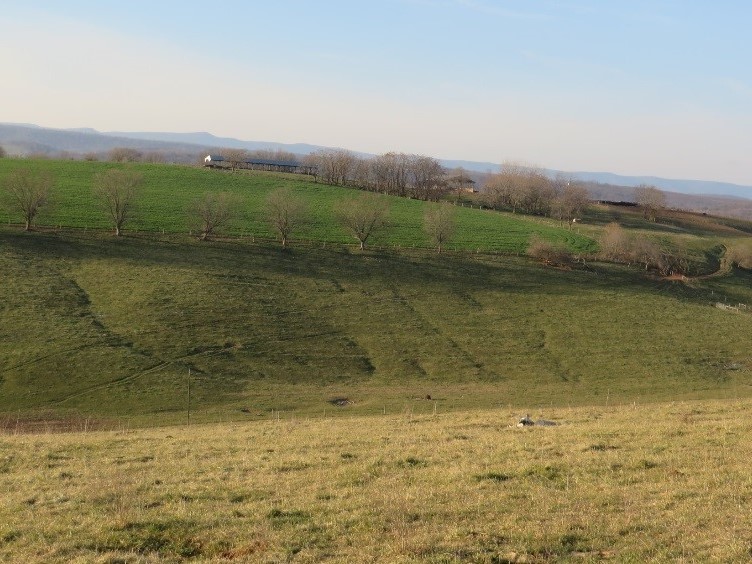Matt Booher, Rockingham County Extension
540-564-3080, mrbooher@vt.edu
You’ve been approached by someone wanting to rent your farm. More than likely, there are several producers waiting in line behind them, each with a different plan in mind and bringing a different skill set and land ethic to the table. There are a number of factors you should take into consideration before making a decision. Here are just a few based on experience with clientele on both sides of the lease agreement.
Conservation of soil and water resources
Over the past 200 years, agricultural land in the Shenandoah Valley has seen its share of environmental resource problems. In many cases, conservation practices adopted by farmers have made great strides in reducing soil erosion and improving surface and ground water quality. While conservation practices such as cover cropping, vegetative buffers, contour farming, and no-tillage planting should always be encouraged in a rental agreement, it is important to know the natural limitations of some soils. Soils on rolling or steep topography are prone to erosion, even under the best of conservation practices.

[This pasture still shows the effects of erosion that occurred when the field was cropped nearly 100 years ago.]
Consider that the erosion of a layer of soil the thickness of a dime represents 10 tons of soil loss per acre, and it is easy to visualize how some ground could easily be impacted forever by just one year of mismanagement. Adjacent streams or rivers are often the recipient of eroded runoff soil and associated nutrients. The best use of highly erodible soils are in a permanent forage crop such as hay or pasture.
Soil compaction is not often discussed, but can be an issue. Most producers are dedicated to avoiding it, but one bad operator with heavy equipment on soils that are too wet can cause compaction or ruts that will last a long time.
Also, consider the nutrient status of your soils. While grazing land as pasture returns around 95% of the nutrients back to the system, harvesting hay or silage removes massive quantities of nutrient from your soils. While most renters are good about adding fertilizers or manures annually, it can often be economically difficult to keep up with the full nutrient removal. Be sure to discuss the budgeting of nutrients on your farm so your soils are not in a steady state of nutrient decline. Manures are often a point of contention due to odors and neighbor perception, but can be a valuable source of affordable nutrients. Be aware that soil pH is the most important soil fertility factor to measure on your farm. While some renters are hesitant to invest in liming soils, it has an enormous short- and long-term impact on weed pressure, soil fertility, and yield.
A long-term lease of at least 3-5 year can give renters the assurance needed to invest more in soil fertility, conservation practices, and to treat land as they would their own.
Aesthetics & land use
Consider what you want your farm to look like. Many landowners prefer the pastoral look of hay or pasture, and may or may not find 12-foot tall corn, or crop stubble and bare earth to be appealing. For hay ground, landowners often prefer to have grasses kept in a vegetative state rather than tall and stemmy. From an agronomy or producer point of view, allowing grasses to mature is not detrimental to plants, and is only temporary. Either way, be sure to communicate your expectations.
Also, consider your expectations for weeds– what is an acceptable level? For pasture, think about your expectations for feeding areas or other areas of animal concentration. Discuss fence maintenance and reseeding or renovation of pastures. When dealing with hay, or row crops such as corn or soybeans, consider equipment traffic during planting and harvesting.
Is your farm a good place to hunt? If so, discuss who has rights to hunt on the property and how should they access it.
Lastly, consider what you would like the land to return to at the end of the
lease period. It can cost $150 or more per acre to convert crop land back into hay or pasture, not including the cost of lost production during the establishment period. If the lease term ends at the conclusion of the growing season for corn or soybeans, is a cover crop specified to prevent soil erosion and nutrient loss?
Land rental rates
Land rental rates vary greatly depending on many factors including the year, commodity crop and livestock prices, location, soil productivity, and farm infrastructure. Virginia Cooperative Extension surveys farmers in the Shenandoah Valley every two years to get a snapshot of land rental rates. Rather than basing rental rates solely on price, it is recommended that landowners consider the issues discussed in this publication along with producers’ performance on other rented land, long-term stewardship of resources, and a shared vision for the producer and landowners responsibilities in the relationship. It is strongly recommended to develop a lease agreement in writing.
For more information on land rental survey results or developing a written lease agreement, please contact the Augusta County Extension Office at 540-245-5750